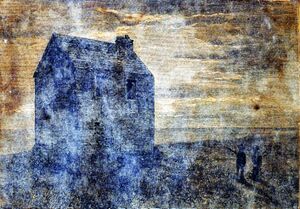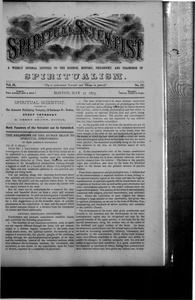< The Poetic Clairvoyance (continued from page 3-204) >
soon as the fine frenzy or quasi trance-state is fairly established, the consciousness watches the torrent of thoughts and arrests the ones wanted, singly with their fitting expression, or in groups of fortunate sequences which he cannot better by after treatment. As the poetical vocabulary is limited and its plasticity lends itself to certain moulds, the mind works under great difficulty, at least until it has acquired by practice such handling of language that every possibility of rhythm or rhyme offers itself actually or potentially to the clairvoyant perception simultaneously with the thought it is to embody. Thus poetical composition is the most intense, the most exciting, and, therefore, the most exhausting of mental exercises. It is exciting because its mental states are a series of revelations and surprises; intense on account of the double strain upon the attention. The poet is not the same man who seated himself an hour ago at the desk, with the dust-cart and the gutter, or the duck-pond and the haystack and the barnyard fowls beneath his window. He is in the forest with the song-birds; he is on the mountain-top with the eagles. He sat down in rusty broadcloth, he is arrayed in the imperial purple of his singing-robes. Let him alone now, if you are wise, for you might as well have pushed the arm that was finishing the smile of a Madonna, or laid a rail before a train that had a queen on board, as thrust your untimely question on this half cataleptic child of the muse, who hardly knows whether he is in the body or out of the body. And do not wonder if, when the fit is over, he is in some respects like one who is recovering after an excess of he baser stimulants.
The Development of the Human Eye
To the Editor of the Spiritual Scientist:—
Sir:— Many people will not believe in the existence of anything they cannot see. They deny the existence of spiritual matter and a spirit-word; because it cannot be demonstrated to the eye by means of a telescope or microscope. I think, therefore, that the following article (translated from the German), will be of interest to your readers.
Yours,
Fredericksburg, Texas, Nov. 8, 1875.
Science gives interesting details how in ancient times the human eye was constituted, and now it will be perfected in the future. The Indian Ideas—the oldest written records— testify, that in most ancient, but yet most historical times, only two colors were known; black and red. After the lapse of many centuries, the eye arrived at a state of greater perfection and was able to recognize yellow; but a much longer period passed away before green could be recognized.
The ancient Greeks possessed a far better developed sense for distinguishing colors; and yet it is proved that the Grecian painters, at the time of Alexander, only knew the fundamental colors,—white, black, red and yellow. They had no names for blue and purple, and called these two colors gray and black. The various colors of the rainbow were only slowly recognized, and even the great Aristoteles could only distinguish four colors of the same.
It is well known that if the color-prism is photographed, there is seen on the plate, behind blue and purple, yet another impression of a color; which color, however, we cannot yet recognize.
It is more than probable that a time will arrive, when the more perfect human eye will distinguish this color also.
The Relations of the Human Brain to Spiritual Phenomena
Col. H. S. Olcott,—
Dear Sir: I have learned with great pleasure that your investigation of the materializations at the Eddy house are to be published in a permanent form, and I envy your recent opportunity. After spending months upon dry verbosities and fruitless dialectics of Plato, Kant, Hamilton and other members of the Metaphysical Adoleschion looking through a barnfull of chaff for a handfull of wheat—it is delightful to see what new and wonderful additions to our practical psychology are being made.
You are working along that charming borderland where the spiritual and physical come together, where the physical rises into the poetic, and the supernal comes down to meet it in beauty and benevolence, as the sunset sky blends with the vapory horizon in the west.
But we must not let enthusiasm for a scene of the marvelous and beautiful divert us from a strict and accurate scientific examination. In such an investigation I should have been happy to cooperate, but as this was not possible, I proffer a few suggestions as to the Scientific basis of psychic phenomena in the constitution of man and the aspect which the matter assumes viewed at a distance from the standpoint of science and literal philosophy.
Psychometry and nervanic experiments establish clearly and positively the following propositions:
l. The faculties of our conscious existence, soul, or spirit are not vaguely diffused through the body, but are concentrated to a definite organic connection in the brain, from which centre alone, the spiritual controls the material, or to express it anatomically, the psychic ganglia of the cerebrum, acting through the psycho-physiological ganglia of its base and the cerebellum, control all the voluntary motions, while they influence the involuntary motions, the circulation, and secretions, as was shown in my experiments upon Dr. Lane of Boston, reported by a committee of physicians.
2. The base of the brain is in more intimate connection with the body and all the processes of physiological life than its upper portion; and a dividing line might be drawn between that portion; which is chiefly physiological and that which is chiefly psychic or spiritual (Psyche, soul and spirit, being nearly synonomous terms). The psychic and physiological hemispheres, however, are not seperated by any definite line, but blend insensibly everywhere.
3. In the psychic half of the brain the faculties are not all equally psychic, as those adjacent to the boundary mentioned (which may be rudely illustrated by a line drawn from the lower margin of the orbit of the eye backward and upward to the crown, at which the hair turns out from a center) are much more physio logical while those farther from that line are much more psychic; the maximum psychiality being on the median line, adjacent to the falx, on the internal aspect of each hemisphere.
4. In the comprehensive view of the human constitution which belongs to Sarcognomy, we ascertain that the superior portions of the body are in more intimate relations with the psychic element than the inferior. The brain is the psychic organ par excellence, and next to the brain the bronchial region of the thorax bas the greatest amount of psychic relation.
From these anatomical and physiological data, it follows that all the transcendental or supernal relations of man, belong to the anterior-superior region of his brain and that the highest manifestations of spiritual capacity will be found where the inner portion of the front lobe as well as the gunis fornicatus and other convolutions adjacent to the corpus cullosum have the largest development. This portion of the brain it also intimately connected with religion, practical benevolence, and universal love. Hence the cultivation of pure religion has always developed a large amount of true spirituality, and given rise to spiritual phenomena, as we see in the lives of Wesley, Fox, Swedenborg, and hundreds of saints, mystics, and ecstatics in the Catholic Church.
The development of the front lobe gives prominence and breadth to the forehead, and the development of the interhemispherical region may be recognized not only by the general breadth of the upper portion of the head, but by the special prominence, along the median line, of the centre of the forehead and upper surface of the brain. As these developments predominate over the animal region of the bruin, we have an increasing sensibility, delicacy, refinement, and spirituality in the constitution, which shows itself in many ways—in a delicate sensibility to the weather and ability to predict its changes; in extreme sympathy with the sick and ability to appreciate their coadition; in a quick sensibility to the character or emotions of others, feeling their presence and their character before they have given any indications; in mys-<... continues on page 3-206 >

Editor's notes
- ↑ The Development of the Human Eye by unknown author, Spiritual Scientist, v. 3, No. 13, December 2, 1875, p. 149. The Spiritual Scientist
- ↑ The Relations of the Human Brain to Spiritual Phenomena by Buchanan, Joseph R., Prof., Spiritual Scientist, v. 2, No. 12, May 27, 1875, pp. 133-4
- ↑ image by unknown author
Sources
-
Spiritual Scientist, v. 3, No. 13, December 2, 1875, p. 149
-
Spiritual Scientist, v. 2, No. 12, May 27, 1875, pp. 133-4



